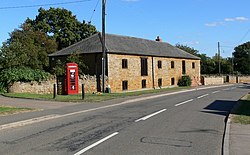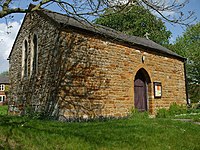Drayton, Leicestershire
| Drayton | |
| Leicestershire | |
|---|---|
 Main Street, Drayton | |
| Location | |
| Grid reference: | SP830922 |
| Location: | 52°31’16"N, -0°46’37"W |
| Data | |
| Population: | 190 (2011) |
| Post town: | Market Harborough |
| Postcode: | LE16 |
| Local Government | |
| Council: | Harborough |
| Parliamentary constituency: |
Rutland and Melton |
Drayton is a small village in south-eastern Leicestershire, bordering Northamptonshire and Rutland. It is found on the north side of the Welland valley, five miles south-west of Uppingham in Rutland and seven miles north-east of Market Harborough, which spells over the Leicestershire-Northamptonshire border. Nearby villages are Bringhurst, Great Easton and Nevill Holt.
The church of St James in Drayton is one of the smallest churches in Church of England.
History
The village's name means 'farm/settlement used to carry portage' or 'farm/settlement used as a dragging place'.[1]
Drayton grew up around an oval green of which the present green is the north-western end. West of the green, Drayton House is a tall red-brick structure, built in 1851–52 for Bryan Ward, a tenant of the Rockingham Castle estate. South of the road to Great Easton the present Manor House Farm, or College Farm, was built c. 1870–80, probably for a relative of Lord Sondes, whose arms it carries. Its cart shed, a dilapidated ironstone structure retaining several stone-mullioned windows, was once a large house carrying the inscription 'H.N. 1651 T.W.' on a stone now built into the wall of the field behind. This was probably the chief messuage of the manor belonging to Henry Nevill and occupied by his tenants, the Watson family. The older houses in the village are of ironstone and include a thatched cottage south of Drayton House in which part of a cruck blade has been re-used as a principal rafter. A mutilated cruck truss is visible in a derelict stone cottage north of the road to Easton. The former Plough Inn is a stone building, partly thatched, of which the older portions probably date from the 17th century. A stone cottage on the road to Easton has a tablet of 1791, a date at which ironstone was evidently still in general use. The village contains several 19th-century brick cottages, including a row dated 1870. There are two pairs of council houses on the Great Easton road built after the First World War and three pairs on the road to Nevill Holt, built in 1950. The village hall, given by Mr Webb of Drayton House, is a wooden structure which was opened in 1925. It was renovated in 2019 after falling into disrepair.
The present civil parishes of Drayton and Great Easton were formerly part of the ancient parish of Bringhurst which possesses the mother church of St James church in Drayton. In 1086 the manor of Easton, which included the greater part of Bringhurst parish, belonged to the Abbey of Peterborough. The only portions of Bringhurst parish not controlled by the abbey were Drayton and the lost mediæval village of Prestgrave. Land in these places, which was omitted from the Domesday Survey, came under the lordship of the Bassets of Weldon (Northants). At the time of the 1381 poll tax 133 persons were listed in Easton, 43 in Drayton, 26 in Bringhurst, an order of size that has since been maintained. In 1563 there were 70 households in Easton and 21 in Bringhurst and Drayton combined. At the 2011 Census, Drayton had 68 households and a population of 190.
Church of St James

The church of St James stands on the green in Drayton. It is a Grade II listed building.[2]
The church is a single room built of stone and roofed with slate, constructed on the site of the former chapel which fell out of religious use in the 18th century and had been converted into a bake-house by 1794. In 1878, George Lewis Watson of Rockingham Castle bought the building and proceeded to remodel it throughout 1878-79 into a mission church. The door is in the centre of the south side; the east end has one, and the west end two, lancet windows. A bell on a bracket projects from the east end. A large semi-circular arch internally suggests that it was of 12th century origin. It is said to be Leicestershire's smallest consecrated church.
Outside links
| ("Wikimedia Commons" has material about Drayton, Leicestershire) |
References
- ↑ Place-Names
- ↑ National Heritage List 1061628: Church of St James (Grade II listing)
- A History of the County of Leicester - Volume 5 pp 49-61: Bringhurst (Victoria County History)
